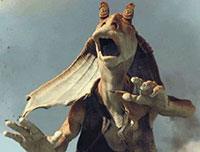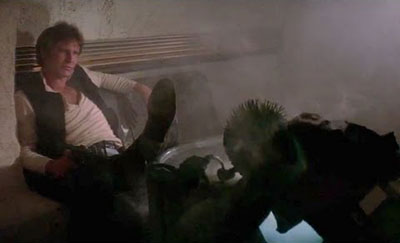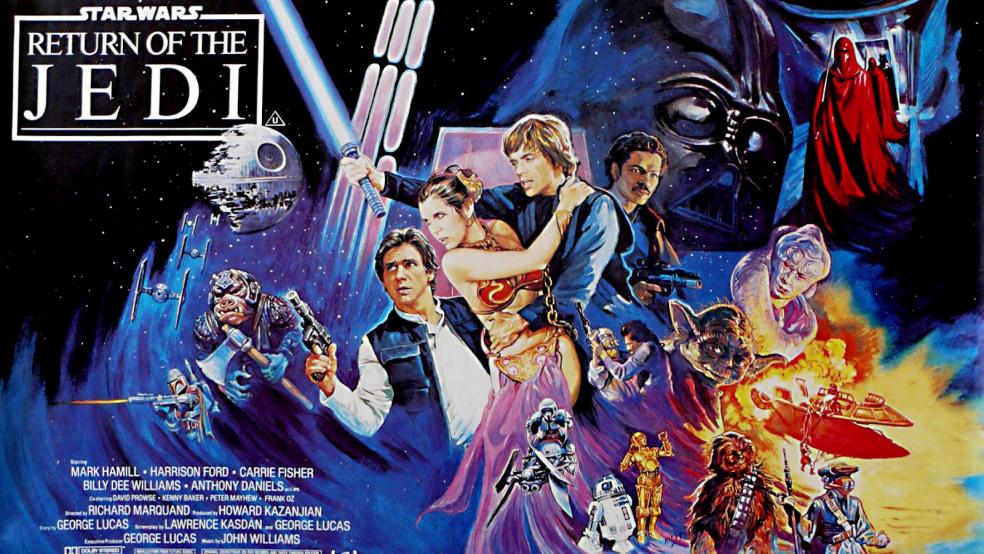You could be forgiven for thinking that only one movie will be released this holiday season. Despite a new entry in the revitalized James Bond franchise and an intriguing offering called “The Revenant” from “Birdman” director Alejandro Gonzalez Iñárritu and Leonardo DiCaprio, all of the entertainment world’s focus is on Hollywood’s latest trip to a galaxy far, far away.
In case you somehow hadn’t heard, “Star Wars: Episode VII – The Force Awakens” hits theaters on Dec. 17.
The obsessive onslaught of Star Wars coverage often assumes that you not only know every detail of a 38-year-old-film, its various sequels, its endless ancillary products, novels, comic books and video games, but also that you are waiting with baited breath and sweaty palms for the latest installment.
In case you’re oblivious to the hype — maybe you were born after 1983 and didn’t have nerdy parents or older siblings, maybe you’re a boomer, baffled that the kids are still talking about that space movie, or a Gen-Xer who grew up in an isolated bunker— never fear, I’ve got you covered. Here are answers to all your Star Wars questions, or at least everything you need to know to get by while those around you are geeking out.
Related: Star Wars: The Rise of a Financial Empire
I don't have time to binge watch the series. What’s Star Wars about?
A farm boy named Luke Skywalker intercepts an SOS message from a kidnapped princess and — with the help of a weird old man, two bickering robots, a charming asshole named Han Solo and (his 8-foot-tall bipedal dog) — he sets off on a rescue mission. He then gets involved with the princess's revolutionary group, learns some mysterious voodoo and discovers that he's basically related to everyone, including the main villain.
The good guys win in the end.
And it’s not the same as “Star Trek”?
No. Though superficially similar and with no small amount of overlap in fan base, “Star Trek” prides itself on its feasibility. The very science that Wars ignores, Trek embraces. Trek is both more serious and, generally speaking, less fun.
This distinction is further blurred by the fact that J.J. Abrams, director and overseer of the new “Star Wars” film, also directed and oversaw the recent “Star Trek” reboot. The general feeling, however, is that Abrams made a successful Trek reboot by making it more like “Star Wars.” The assumption is that he will be far more at home in this universe.
So what exactly is a Jedi?
Well, kind of a combination between a samurai, a wizard and a space cop. In the backstory of the film, the Jedi once kept order in the galaxy but were (almost) wiped out by the rise of the evil empire. (Star Wars politics are essentially like Rome under Nero, complete with the longing for the restoration of the dead Republic.)
And what’s Darth Vader?
Oh, come on. You’ve seen his famous black mask and heard the iconic deep breathing. He’s the main villain of the piece — and was recently voted the greatest movie villain of all time, with good reason. On top of his intimidating appearance, there is also the immense physicality brought to the role by bodybuilder David Prowse, and of course the epic bass of the great James Earl Jones, which instantly made him the stuff of children’s nightmares. Spoiler: The shocking reveal at the end of “The Empire Strikes Back” is that Darth Vader is in fact the long-dead father of our hero. The twist may have long since passed into cliché, but the revelation in 1980 shocked a legion of fans to their core and has kept Vader at the center of pop culture for almost 40 years.
So how many “Star Wars” movies are there?
Six — the new one will be the seventh. But it’s not so simple. The first movie to be released, in 1977, was called “Star Wars,” but once that film became a phenomenon it was rebranded “Episode IV: A New Hope" and the overarching series was then referred to as Star Wars. For older fans, this change has never totally set and they (we) will often refer to the first film as simply “Star Wars.”
Why is Star Wars such a big deal? Why are people insane about it?
Look, it is not a fan-boy exaggeration to say Star Wars changed the world. It did, both for better and worse. The thoughtful, methodical tone of 1970s cinema was replaced by the high-octane, high-concept overdrive of the 1980s. Steven Spielberg’s “Jaws,” released in 1975, was the first blockbuster, but Star Wars was the first blockbuster franchise. Without it, there would be no “Terminator,” “Aliens,” “Lord of the Rings,” “Harry Potter” or “Hunger Games” movies. The superhero movie boom would almost certainly not be taking place. With Star Wars, Hollywood learned that the Young Adult Market was the most lucrative market, and would increasingly focus on this market, to the exclusion of all others.
Related: The 10 Most Valuable Star Wars Figures
And on a more sociological level, a generation of young people are now hitting middle age, with our defining myth being that of a rag-tag group of individualists taking on a monolithic empire and winning. Like it or not, Star Wars is a force to be reckoned with.
And why exactly was the movie ground-breaking?
In a time before VCR, DVDs, 1,000-channel cable packages or Netflix, access to older movies was much more limited. Access to older television shows was almost unheard of and so the idea of doing a “reboot” or a remake or even directing something inspired by the cinematic style of a past decade was actually revolutionary.
A promising, young, artistically minded director named George Lucas remembered his childhood joy at watching Flash Gordon serials in the movie theater (TV episodes before TV, they would be shown ahead of more respectable movies or lumped in a marathon for kids) and so decided to make a film inspired by those childhood delights. That’s right, “Star Wars” was an art film.
Lucas received heavy criticism for his choice. This was a time when the box office was ruled by “The Godfather” and “Annie Hall” (which beat “Star Wars” for Best Picture at the Oscars). Literally billions of dollars later, Lucas has had the last laugh.
However, in keeping with the style of the Flash Gordon serials, Lucas opened the film with the famous crawl, labeling it Episode IV. The idea was to give the impression that you were walking into the recovered middle chapter of a long-lost serial. Of course, following the wild success of “Star Wars,” fans and studio executives all wanted to know what was in those other chapters. And Lucas was only too happy to oblige, starting a war between his commercial and artistic impulses that would rage for decades.
Ok, but really, they’re just movies, no?
No — and that’s why Star Wars matters. It’s become the prototypical cinematic merchandising machine. Between 1983 and 1999, the movie series laid dormant. Many suspected that Lucas would simply never return to the franchise — that he was happy running his exceptionally successful special effects studio and would rather not return to the franchise that both made him wealthy and destroyed his notion of himself as an artist.
But the Star Wars galaxy was far from dormant. Sales of toys and other merchandise continued and a whole “extended universe” developed. Dozens upon dozens of novels, comic books and video games attempted to plug the gap, telling the stories of what happened after the end of the third Star Wars movie, “Return of the Jedi.” To many fans, these stories — of Luke’s duplicitous lightsaber-wielding girlfriend, of Han and Princess Leia’s relationship and the fates of their children and the various attempts by the remnants of the Empire to restore their former power — are just as much a part of the narrative as the six canonical films.
People really hate those later movies?
Yes, with a lingering disappointment and bitterness that has become part of “Star Wars” lore.
Why?
Expectations for the new movies could not have been higher, which meant when the final product was less than perfect (and even without those expectations, they are far less than perfect), the reception was disastrous.
Rather than allowing Star Wars to age with its fans, Lucas returned from a lengthy self-imposed hiatus (1983-1999) and attempted to make a film aimed at pre-adolescent children. And while the same critique could be leveled at the original trilogy, Lucas was no longer the young man saying, “Hey kids, let me show you something cool.” He was a middle-aged man pandering to a young audience. Worse than that, his success bucking criticism as a young man had left him deaf to critique as a successful older one. He believed that he alone knew what was best for Star Wars. The second Star Wars trilogy was enormously successful at the box office and kept the franchise in the public eye, but also created a permanent rift in its fan base.
Also, Jar-Jar Binks.
Who or what is a Jar-Jar Binks?

Good question. Jar-Jar Binks is a supporting character in Episodes I-III. He is an entirely CGI alien, speaks in a ludicrous sub-Jamaican accent and frequently engages in a kind of lowbrow humor that is almost entirely absent from the original trilogy. For hardcore fans, he is the symbol of everything that is wrong, contrived, tone deaf and manipulative about the second trilogy.
If the last trilogy was widely panned, why are they making more?
It’s safe to say that the faults of the second trilogy fall pretty firmly at the feet of Lucas. He ruled his empire with an iron fist and seemed to take an almost perverse delight in the detractors who had once been his biggest fans. Many assumed that the franchise would remain in his clutches until he died, which is why it was such a surprise that he sold the rights to his baby to Disney in October of 2012 for a whopping $4 billion (all of which, in full credit to a man I’ve said a lot of nasty things about, he gave to educational causes). And while no one believes that the new films will hold a candle to the originals, there is simply no way they could possibly be as bad as the prequels … right?
Who are these old people that everyone is excited have “come back”?
The three stars of the original trilogy all went on to have varied careers in Hollywood. Harrison Ford’s career may have come off the boil for the past decade or two, but in the ‘80s and ‘90s there was no more successful actor. Recently, the old grump has retreated with his wife to the wilds of Montana, where he flies his private jet rescuing stranded hikers (seriously). Despite there not being a huge difference between his roles as Indiana Jones and Han Solo, he has always loved the former and detested the latter. Ford’s willingness to return is part of the reason fans have hope for the new films.
Carrie Fisher, the daughter of actors Debbie Reynolds and Eddie Fisher, was only 19 when first cast. Though she would have memorable supporting roles in movies such as “The Blues Brothers” and “When Harry Met Sally,” she could never really shake the role of Princess Leia. She instead has forged a career as both a novelist and one of the most in-demand script doctors in Hollywood.

Finally, there is the young hero of the first trilogy, Mark Hamill. Even more than Fisher, Hamill was never able to shake his iconic role as Luke Skywalker. He has, though, carved out a very respectable career as a voice actor, including a beloved (and truly awesome) 20-year run as the voice of The Joker in “Batman: The Animated Series” and its subsequent adaptations.
What is the bare minimum I need to do to follow the new film?
Chances are, the new films will not pull a large amount of material from the second trilogy (confusingly, the first in the fictional chronology). Episodes IV, V and the first half of episode VI are all legitimately entertaining films … and you might as well watch the back half of Episode VI (“Return of the Jedi”) just to get to the end of the story and to start to see the beginnings of the toymaker’s empire that would overshadow the later films.
I’ve heard something about someone shooting first?
Yeah, as sort of a warm-up act to his return to the galaxy, Lucas revisited the original trilogy in 1997. With the newly invented technology of CGI, he took a digital paintbrush over his early work. In fairness, some of the changes are good; the space battles do look more epic. But many scenes just seem overly stuffed with digital detail.
 The most controversial change was to the contents of an iconic scene. In one of Han Solo’s early scenes, an alien bounty hunter confronts him at gunpoint regarding outstanding debts. Han nonchalantly draws his pistol under the table and shoots the alien, thus establishing himself as quite literally a “shoot first, ask questions later” kinda guy.
The most controversial change was to the contents of an iconic scene. In one of Han Solo’s early scenes, an alien bounty hunter confronts him at gunpoint regarding outstanding debts. Han nonchalantly draws his pistol under the table and shoots the alien, thus establishing himself as quite literally a “shoot first, ask questions later” kinda guy.
The adult Lucas was disturbed by this portrayal, finding it distastefully cold blooded. He (clumsily) inserted a blast from the bounty hunter, making Han’s shot an act of retaliation rather than a preemptive strike. Fans already irritated with the “Disney-fication” of the films were livid.
Of course, the irony is that Disney is now their savior.
Is there any chance of avoiding a whole new wave of Star Wars hype?
Only if you move back to that isolated bunker, and maybe not even then.
So how big is this new movie going to be?
Over the last 40 years, the Star Wars franchise has made $37 billion and it’s safe to say that the new film will add significantly to that total. Even the worst performing of the films, 2002’s “Attack of the Clones” pulled in over half a billion dollars in its initial release. Even bad Star Wars movies make lots of money. “Jurassic World,” this year’s top grossing film, has pulled in $650 million. Expect the news “Star Wars” to beat that during its initial run.
And then there will be more of these movies?
Oh heavens, yes. Disney is going to milk this franchise for every dime it can get. Episode VIII and a stand-alone film are already in pre-production, with multiple spin-off films for the franchise’s iconic side characters in development. Star Wars is nearly 40 years old, and it’s just getting going.




